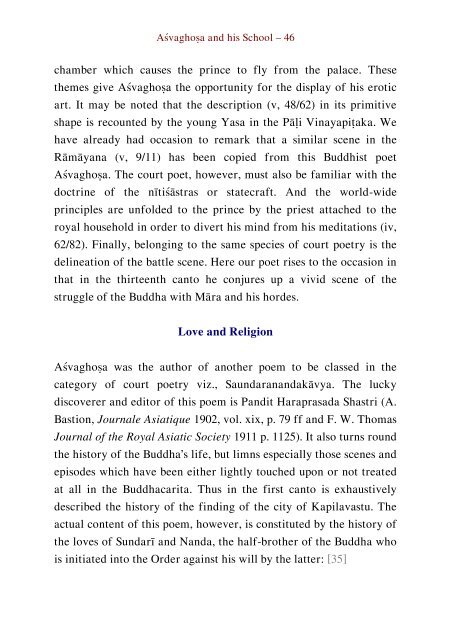Literary History of Sanskrit Buddhism
A study by J. K. Nariman of Sanskrit Buddhism from the Early Buddhist Tradition up to the Mahayana texts proper.
A study by J. K. Nariman of Sanskrit Buddhism from the Early Buddhist Tradition up to the Mahayana texts proper.
You also want an ePaper? Increase the reach of your titles
YUMPU automatically turns print PDFs into web optimized ePapers that Google loves.
Aśvaghoṣa and his School – 46<br />
chamber which causes the prince to fly from the palace. These<br />
themes give Aśvaghoṣa the opportunity for the display <strong>of</strong> his erotic<br />
art. It may be noted that the description (v, 48/62) in its primitive<br />
shape is recounted by the young Yasa in the Pāḷi Vinayapiṭaka. We<br />
have already had occasion to remark that a similar scene in the<br />
Rāmāyana (v, 9/11) has been copied from this Buddhist poet<br />
Aśvaghoṣa. The court poet, however, must also be familiar with the<br />
doctrine <strong>of</strong> the nītiśāstras or statecraft. And the world-wide<br />
principles are unfolded to the prince by the priest attached to the<br />
royal household in order to divert his mind from his meditations (iv,<br />
62/82). Finally, belonging to the same species <strong>of</strong> court poetry is the<br />
delineation <strong>of</strong> the battle scene. Here our poet rises to the occasion in<br />
that in the thirteenth canto he conjures up a vivid scene <strong>of</strong> the<br />
struggle <strong>of</strong> the Buddha with Māra and his hordes.<br />
Love and Religion<br />
Aśvaghoṣa was the author <strong>of</strong> another poem to be classed in the<br />
category <strong>of</strong> court poetry viz., Saundaranandakāvya. The lucky<br />
discoverer and editor <strong>of</strong> this poem is Pandit Haraprasada Shastri (A.<br />
Bastion, Journale Asiatique 1902, vol. xix, p. 79 ff and F. W. Thomas<br />
Journal <strong>of</strong> the Royal Asiatic Society 1911 p. 1125). It also turns round<br />
the history <strong>of</strong> the Buddha’s life, but limns especially those scenes and<br />
episodes which have been either lightly touched upon or not treated<br />
at all in the Buddhacarita. Thus in the first canto is exhaustively<br />
described the history <strong>of</strong> the finding <strong>of</strong> the city <strong>of</strong> Kapilavastu. The<br />
actual content <strong>of</strong> this poem, however, is constituted by the history <strong>of</strong><br />
the loves <strong>of</strong> Sundarī and Nanda, the half-brother <strong>of</strong> the Buddha who<br />
is initiated into the Order against his will by the latter: [35]


















